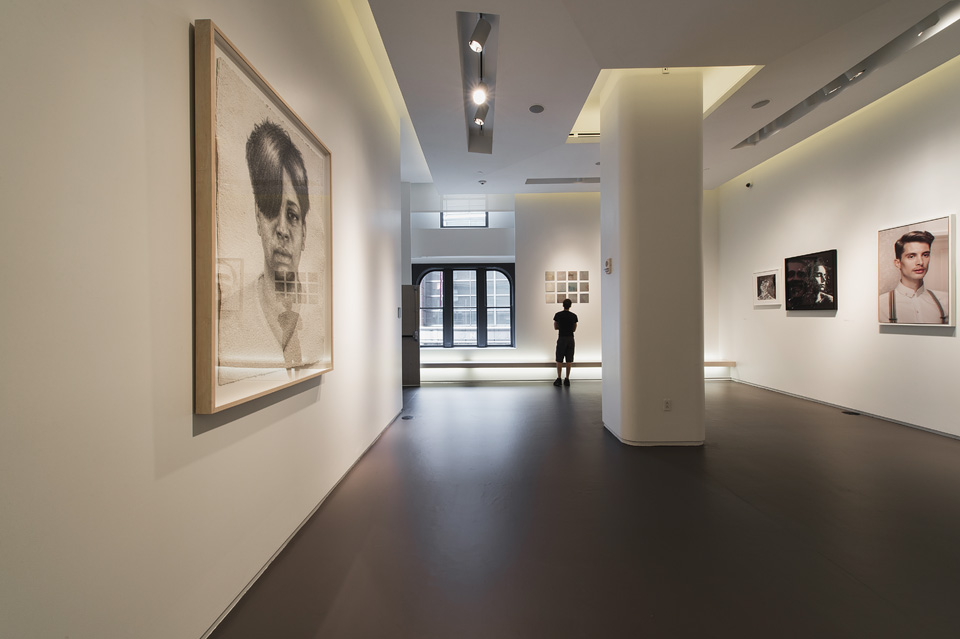For years, sometimes lifetimes, we search for our true self. WHO AM I?? What is our identity? Are there shifts or is there some sort of constant or permanence within, explaining the adage that some people never change. People say that in your youth each year is such a learning experience and you are continually evolving into the person you will become. Then, further along in life, each decade is revered for each one’s set of wisdom and practicalities. Now, in the Google era of the online profile and photo apps, how are we perceiving ourselves and others around us through these stereotypical decades? Once thought to be timeless and universal, have things finally changed in our own patterns of change?
In an essay written for Dis-semblance, 21c Chief Curator and Director of Arts Programming Alice Gray Stites observes that in the global theatre of self-invention, identity is often a remix of time, subject and media. Says Stites, “In a constant state of projecting and connecting, how and what do we understand about ourselves and others? Dis-semblance examines the evolution of portraiture as a platform for capturing the ebb and flow of the mutable, hybrid self, and as a multi-faceted mirror of the fractured identities we shape, desire and exchange in our now intertwined analog and digital lives, onscreen and off.” The mediums used in the show are varied and, suggests Stites, sample visual sources in the way musicians and producers sample songs, taking bits from the past and spinning them into modern arts – while still paying homage to the predecessor. “With unprecedented access to a vast array of cultural traditions, artists today sample from histories near and far, subverting conventional images of race, ethnicity, gender, and role-playing, reinventing portraiture as a new genre.”
21c Cincinnati Museum Manager Eli Meiners echoes Stites observations, saying, “I feel that the works speak to our techno-centric age in material and metaphoric ways. A perfect example can be found in Jeppe Hein’s Mirror Wall, an interactive piece which calls attention to the impermanence of identity.” In Mirror Wall, viewers approach a large mounted mirror within the space of the gallery. Upon arrival, the mirror begins to vibrate, creating a fragmented reflection that mirrors the fragmented self. When asked what some of his favorite pieces are or which he thinks best express the themes of the show, he gives us both. “Those are very different things. The works on display by Sebastian Bremer and Andrew Felipe Castano appeal to me on a personal level, primarily due to the visual dialogue between analog and digital aesthetics. However, I feel Rachel Lee Hovnanian’s Dinner for Two and Yinka Shonibare’s The Age of Enlightenment best express the complexity of identity in our global digital age.”
In Dinner for Two, Hovnanian comments on our attachment to our digital lives. “We are sucked into our screens and can’t find time to separate from technology. Only when the power is down, or if we are visiting a remote place with no wireless, can we take a break.” In it, two screens positioned at either side of a long, decorated table show the faces of a presumed couple – neither who ever meet the eye of the other. Their attentions are held by the electronic device in their palms, which are constantly ringing, beeping, buzzing out to alert them of activity in their virtual worlds. Who of us hasn’t been there? Check please.
Dis-semblance leaves you with a distinct impression that the tides of communication and relation to others through authentic communication aren’t changing – they already have changed. We post photos and thoughts all over social media platforms, changing our profiles to fit our persona du jour – or to fit into the online friend groups we have subscribed ourselves to. Searching through online profiles is the new singles bar, the non-committal version of taking a seat on a stool and hoping for the best, hoping for interaction. Sherry Turkle, author of Alone Together: Why We Expect More From Technology Than We Do From Each Other – which Dinner for Two is based on, says that, “Technology is seductive when it promises to meet our human vulnerabilities. And as it turns out, we are very vulnerable indeed. We are lonely but fearful of intimacy…our network life allows us to hide from each other even as we are tethered to each other. We’d rather text than talk.”
In the end though…what’s really all that wrong with a little reinvention?
> Learn more about the exhibition
> Attend a free Guided Docent Tour



